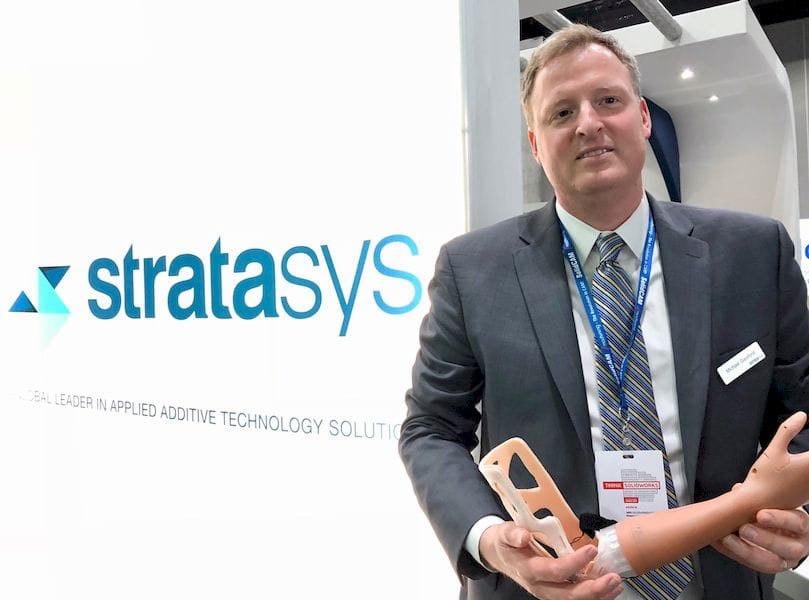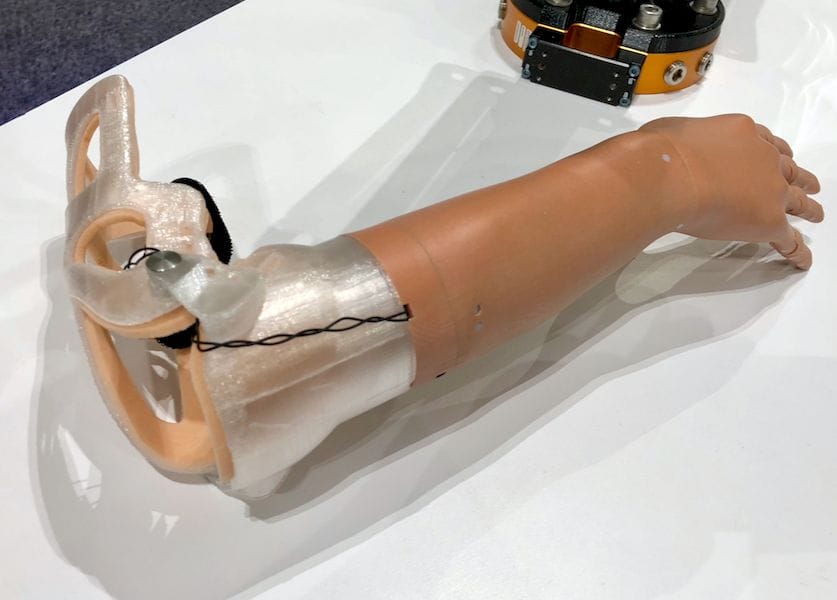
We spoke at length with Stratasys’ Director of Marketing for Healthcare Solutions, Michael Gaisford.
While the conversation centered around their partnership with Unlimited Tomorrow’s Easton LaChappelle to produce sophisticated 3D printed prosthetics, we ventured into several other aspects of 3D printing in the healthcare vertical.
This is part 1 of a 2 part interview. Part 2 is here.
Fabbaloo: Tell me how sophisticated is this prosthetic? It’s not just a bunch of plastic parts, is it?
Michael Gaisford: The sophistication comes on multiple levels. A lot of the 3D printed hands that you’ll see out there have designs you can download and then customize it to the patient. This is built entirely differently. It starts from the digital workflow of 3D scanning for both the stump and the the existing arm.

Have you seen a solution like that? That’s very distinctive in terms of the approach of making sure the hand is designed so that it’s aesthetically going to fit the recipient; it’s going to match. It’s not just going to be generic. But not to put down other designs, but a generic design doesn’t really match. So I think that digital workflow and adding that digital flow is really going to take the full power of 3D printing. Then Easton has put together a full ecosystem of partners to develop the solution, to have that automation, and to be able to quickly translate that data and then create the 3D printer printable files. The actual design of the arm, he can speak to it much better than I, but you heard the elements of it: the machine learning, the neural network, the number of different types of sensors; some arms have just myoelectric, some have other types of sensors and this is integrating a full range of different sensors.
Fabbaloo: What parts of it are 3D printed? Obviously the basic structure is, but is the skin 3D printed?
Michael Gaisford: The entire structure that you see is 3D printed. Everything that you can physically see, up until you get to the point where there’s a foam interface (that’s for a bio compatible interface, for example), the socket is 3D printed as well. But then the internal structure, the mechanics, the robotics, the electronics, those are obviously not 3D printed. Those are built into the hand afterwards.
So there’s a number of things that are I think really distinctive starting from that that workflow. The last element that I think is really distinctive is using the J750 for that aesthetic element that’s going to create a hand that has the realism for the colour matching the high resolution for a very fine finish and then the accuracy to put together all those delicate components. A lot of the components you see for open source hands have the mechanics built into them, but they’re gross mechanics. His is much more fine featured, delicate movement, because he’s got all those intricate components, which the Stratasys J750 with its high resolution and high accuracy is able to create those parts that work so well together.
Fabbaloo: I know that there’s been some other companies that produce like fairings for artificial legs. Style was a big feature. They would come with really wild designs. It’s like a fashion thing. Do you see something like that happening on this project. It sounds like it’s technically possible.
Michael Gaisford: I think Easton spoken to that in the press conference in other situations, that yes he can do the color matching based on the scanning and get my pasty-white skin matched perfectly! But if I’m a kid and I want an arm that looks like my superhero or has a beautiful design that represents you know something I really enjoy about my hobbies or my life you can incorporate that. Now, you can automate that in some ways, like if it’s personalized that then takes some write some manual artwork potentially. But I think the possibility is there especially with the J750 with its ability to do texture mapping and color mapping to wrap it around the arm.
Fabbaloo: Let’s talk about some of the business aspects. You said that you’re helping them print the first hundred units. So, I presume that’s a pretty pretty big financial commitment for that company. But what happens after that? What do you hope will happen after that?
Michael Gaisford: We hope that Unlimited Tomorrow is phenomenally successful and that they’re able to meet this audacious goal of serving the millions of people who don’t have currently an effective prosthetic arm. Certainly if that happens and he continues to incorporate our technology, which will be optimized for those 100, that we would expect to continue to have him use our technology as the basis.
Fabbaloo: There’s this idea of intervening with a startup that has some potential. Is that a standard strategy that Stratasys is employing now? You’ve done it with this startup.
Michael Gaisford: I wouldn’t say that that is an intentional strategy going forward, but there are certainly opportunities where we’ll see an application and we’ll see that it is particularly well suited to additive manufacturing and one of our technologies, whether it’s PolyJet or FDM. When we see that and we see there’s an opportunity that we absolutely will partner with that group to make sure that we are optimizing our solution for that application. So there are cases where we see this, where there’s a very clear fit between the application and our technology and we can do that, but I wouldn’t say it’s intentional “we’re going out and searching the world for these”; they come to us and if we see a fit, we’re certainly more than happy to engage.
Fabbaloo: The J750 has essentially voxel-level control over the output, but there is this big software gap of how you can control a 3D design to produce amazing objects. How big a barrier is the lack of new voxel-level 3D design software to doing more powerful things in the health care area?
Michael Gaisford: Independent of this project, I would say that there are definitely some significant gaps, but the tools are being developed every day. One of the biggest applications in medical is to replicate medical models, human anatomy. Someone had a question about converting DICOM content. That process of taking an MRI or a CT scan and converting it, that’s one of the biggest barriers to hospitals adopting 3D printing technology more broadly. There’s a lot of fantastic tools to do it but you need to be an expert user, or it can take hours to do.
Now we have companies that are really investing in automating that process. You have the big imaging companies like Vital Images, like Philips who we’ve announced a partnership with, like GE Healthcare that have auto segmentation capability in the auto segment the DICOM file and convert it to an STL with minimal cleanup required. That is still a challenge, but it’s a problem that we’re working on with some of our partners on the imaging side and in the software world. Then we’re even doing our own internal work as well: you have the VoxelPrint software that we launched back in November that really harnesses the full power of the printer and opens it up into in a usable interface.
This is part 1 of a 2 part interview. Part 2 is here.

